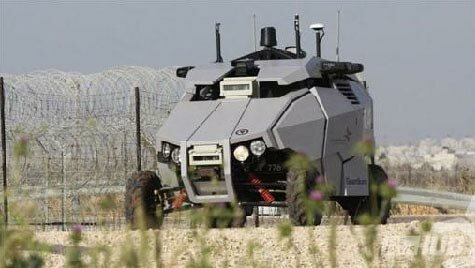
The IDF's Guardium unmanned vehicle - 2009
Israel is developing an army of robotic fighting machines that offers a window onto the potential future of warfare… In 10 to 15 years, one-third of Israel’s military machines will be unmanned, predicts Giora Katz, vice president of Rafael Advanced Defense Systems Ltd., one of Israel’s leading weapons manufacturers.
IOA Editor: As covered in detail by Amira Hass and others, Israeli high technology warfare plays a lead role in spying on and killing Palestinians, most recently in Gaza, a development zone for Israel’s military industries. This will undoubtedly continue – paid for generously by the US, and by Third World client regimes – as Israelis are increasingly intolerant of death of their own, while they readily accept the death of thousands of innocent Palestinians.
By Charles Levinson, The Wall Street Journal – 13 Jan 2010
http://online.wsj.com/article/SB126325146524725387.html?mod=WSJ_hpp_LEFTTopStories
TEL AVIV, Israel – Israel is developing an army of robotic fighting machines that offers a window onto the potential future of warfare.
Sixty years of near-constant war, a low tolerance for enduring casualties in conflict, and its high-tech industry have long made Israel one of the world’s leading innovators of military robotics.
“We’re trying to get to unmanned vehicles everywhere on the battlefield for each platoon in the field,” says Lt. Col. Oren Berebbi, head of the Israel Defense Forces’ technology branch. “We can do more and more missions without putting a soldier at risk.”
In 10 to 15 years, one-third of Israel’s military machines will be unmanned, predicts Giora Katz, vice president of Rafael Advanced Defense Systems Ltd., one of Israel’s leading weapons manufacturers.
“We are moving into the robotic era,” says Mr. Katz.
Over 40 countries have military-robotics programs today. The U.S. and much of the rest of the world is betting big on the role of aerial drones: Even Hezbollah, the Iranian-backed Shiite guerrilla force in Lebanon, flew four Iranian-made drones against Israel during the 2006 Lebanon War.
When the U.S. invaded Iraq in 2003, it had just a handful of drones. Today, U.S. forces have around 7,000 unmanned vehicles in the air and an additional 12,000 on the ground, used for tasks including reconnaissance, airstrikes and bomb disposal.
In 2009, for the first time, the U.S. Air Force trained more “pilots” for unmanned aircraft than for manned fighters and bombers.
U.S. and Japanese robotics programs rival Israel’s technological know-how, but Israel has shown it can move quickly to develop and deploy new devices, to meet battlefield needs, military officials say.
“The Israelis do it differently, not because they’re more clever than we are, but because they live in a tough neighborhood and need to respond fast to operational issues,” says Thomas Tate, a former U.S. Army lieutenant colonel who now oversees defense cooperation between the U.S. and Israel.
Among the recently deployed technologies that set Israel ahead of the curve is the Guardium unmanned ground vehicle, which now drives itself along the Gaza and Lebanese borders. The Guardium was deployed to patrol for infiltrators in the wake of the abduction of soldiers doing the same job in 2006. The Guardium, developed by G-nius Ltd., is essentially an armored off-road golf cart with a suite of optical sensors and surveillance gear. It was put into the field for the first time 10 months ago.
In the 2006 Lebanon War, Israeli soldiers took a beating opening supply routes and ferrying food and ammunition through hostile territory to the front lines. In the Gaza conflict in January 2009, Israel unveiled remote-controlled bulldozers to help address that issue.
Within the next year, Israeli engineers expect to deploy the voice-commanded, six-wheeled Rex robot, capable of carrying 550 pounds of gear alongside advancing infantry.
After bomb-laden fishing boats tried to take out an Israeli Navy frigate off the coast off Gaza in 2002, Rafael designed the Protector SV, an unmanned, heavily armed speedboat that today makes up a growing part of the Israeli naval fleet. The Singapore Navy has also purchased the boat and is using it in patrols in the Persian Gulf.
After Syrian missile batteries in Lebanon took a heavy toll on Israeli fighter jets in the 1973 war, Israel developed the first modern unmanned aerial vehicle, or UAV.
When Israel next invaded Lebanon in 1981, the real-time images provided by those unmanned aircraft helped Israel wipe out Syrian air defenses, without a single downed pilot. The world, including the U.S., took notice.
The Pentagon set aside its long-held skepticism about the advantages of unmanned aircraft and, in the early 1980s, bought a prototype designed by former Israeli Air Force engineer Abraham Karem. That prototype morphed into the modern-day Predator, which is made by General Atomics Aeronautical Systems Inc.
Unlike the U.S. and other militaries, where UAVs are flown by certified, costly-to-train fighter pilots, Israeli defense companies have recently built their UAVs to allow an average 18-year-old recruit with just a few months’ training to pilot them.
Military analysts say unmanned fighting vehicles could have a far-reaching strategic impact on the sort of asymmetrical conflicts the U.S. is fighting in Iraq and Afghanistan and that Israel faces against enemies such as Hezbollah and Hamas.
In such conflicts, robotic vehicles will allow modern conventional armies to minimize the advantages guerrilla opponents gain by their increased willingness to sacrifice their lives in order to inflict casualties on the enemy.
However, there are also fears that when countries no longer fear losing soldiers’ lives in combat thanks to the ability to wage war with unmanned vehicles, they may prove more willing to initiate conflict.
In coming years, engineers say unmanned air, sea and ground vehicles will increasingly work together without any human involvement. Israel and the U.S. have already faced backlash over civilian deaths caused by drone-fired missiles in Gaza, Pakistan and Afghanistan. Those ethical dilemmas could increase as robots become more independent of their human masters.
Corrections & Amplifications
General Atomics Aeronautical Systems Inc. manufactures the Predator unmanned aerial vehicle. A previous version of this article incorrectly stated that General Dynamics Corp. manufactured the UAV.






































